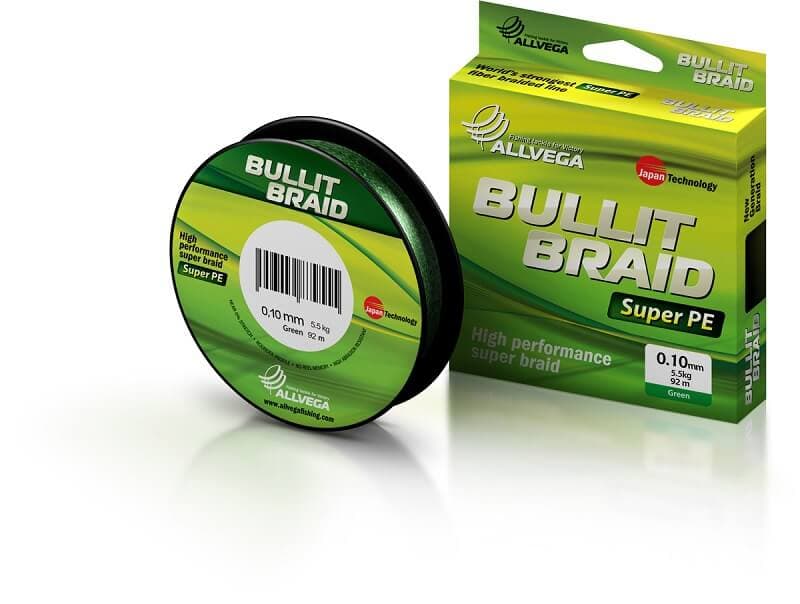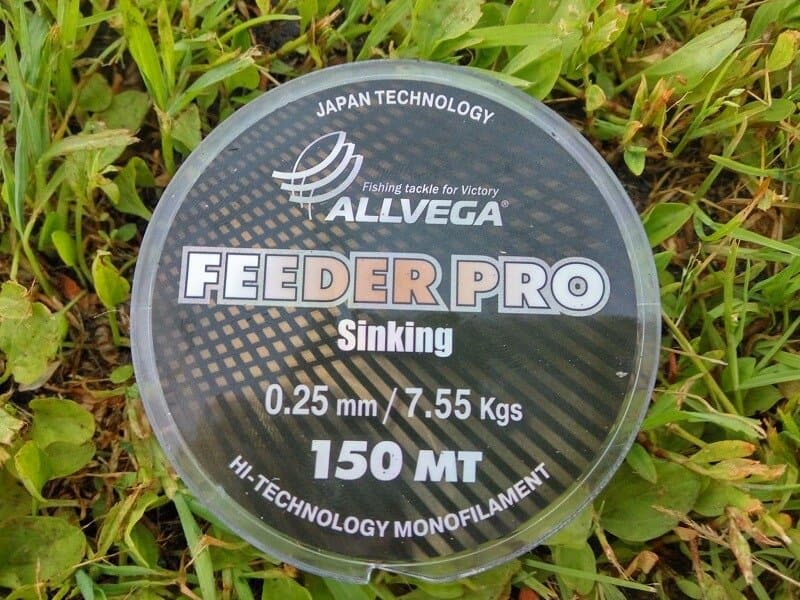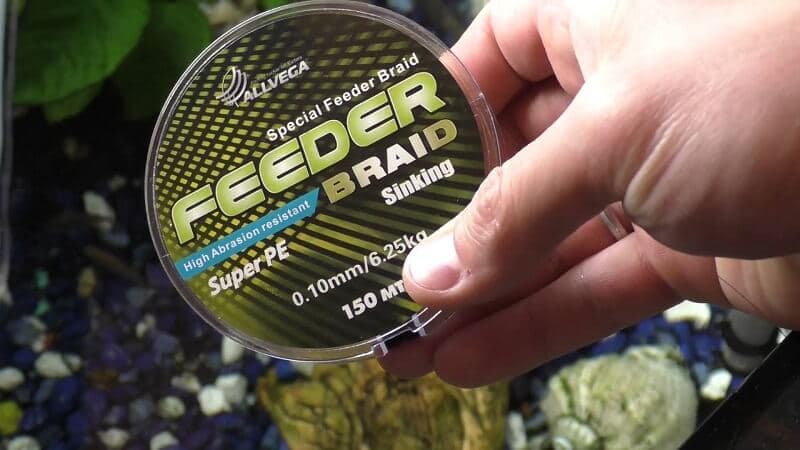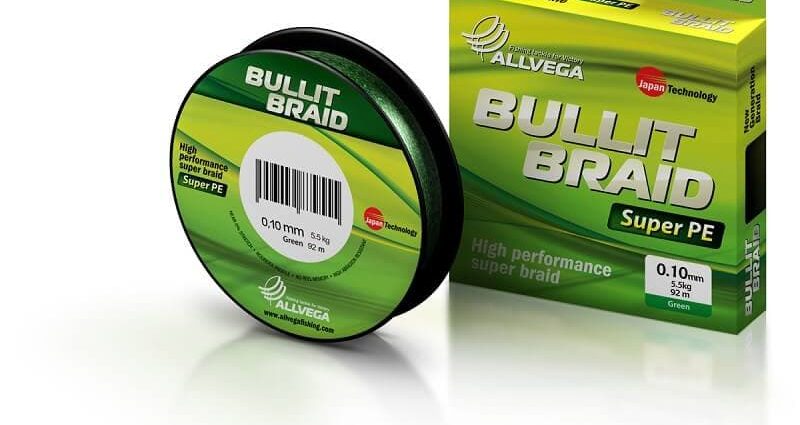Contents
Braided fishing line is very popular with anglers. It is used in spinning, feeder, sea and even winter fishing. When fishing on a feeder, it helps to get good bites and use a lighter weight to hold the bait, which can be essential, especially in competition. However, there are cases when you can do without it, and there are plenty of cons for a braided line for a feeder.
What is better, fishing line or braided line?
You should immediately try to solve the most important question that is faced when equipping the feeder – which is better, fishing line or braided line? There are a number of factors to consider when choosing. In any case, sooner or later, any feederist will have in his arsenal both braided line and ordinary fishing line, as well as rods equipped with both. Here are the factors influencing the choice:
- The braided cord is thinner.
- As a result, the feeder can be cast over a greater distance than with line of the same breaking load. This is critical for long-distance casts on large estuaries and lakes with a slight bottom slope in depth.
- On the course, a thin cord has less resistance, lighter loads can be used. In some cases, fishing is possible only with him.
- It fluctuates much less from the current, has less extensibility. As a result, the bite will be better seen even at a great distance from the shore.
- Will sail less in strong winds.
- For feeder fishing, you can use not very expensive cords, unlike spinning, which makes fishing with a cord possible even for anglers with modest finances. However, ideally, still use expensive and high-quality models.
- Still, the cost of an acceptable cord will be at least twice as expensive as fishing line.
- On the shore, the cord will more often get tangled in clothes, vegetation, fishing equipment than fishing line.
- The service life is much less than fishing line.
- In bottom fishing, this period is even more reduced when fishing on the current in muddy water, rich in sand particles.
- In the cold, the cord freezes over.
- When fishing with a line, you need to use high-quality expensive reels, since it is almost impossible to untangle a beard on it, unlike fishing line. The coil should not throw off loops.
- A beginner with a cord will have many problems. First, they often forget to pick up the rod at the end of the cast. As a result, the feeder will be shot, and this may not happen with the fishing line due to its elasticity. The second is an inaccurate sharp cast of a heavy feeder with an inextensible cord. As a result, the tip breaks, especially often the coal one. Third – the cord will more often than the fishing line, overwhelm the tulip. As a result, you can break the tip of any type or tear off the tulip. There may be other problems as well. With fishing line they will be much less.
- Virtually no cushioning when playing and casting. The fishing line softens both jerks of the fish and too sharp braking on the clip.
- Knitting montages on a fishing line is much easier. On the cord, this can be done comfortably only if there is a loop tie. This is largely due to the popularity of inline installation with a cord, which can be done using knotless and without loop knitting.
- When fishing with a fishing line, you can achieve the same sensitivity in the course as with a line, if you put a carbon quiver tip. The cost of this solution will be more than buying braid and fishing with glass, since carbon tips are more expensive and break more often. Such a decision can only be made in special fishing conditions.

It is worth saying a few words about feeder lines. There are a number of lines specially designed for feeder and carp fishing. They practically do not have extensibility and in this regard are able to compete with cords. In addition, they have a dark color throughout the volume of the line, which prevents light from penetrating into the water along the line, and it does not work as a light guide.
How to make the right choice?
The choice between fishing line or braided line is made by the angler according to his individual fishing experience. For a beginner, it is best to start with a picker 2.4-2.7 meters long, with line on a reel, in a body of water with little or no current and at a short fishing distance. For more advanced anglers, the line is acceptable for fishing with a casting distance of up to 40 meters, with a current of up to 0.5 meters per second. In such conditions, you can fish with a feeder on most of our reservoirs.
As soon as the distance and the speed of the current increase, it is worth using a braided line. At the same time, the value of these two parameters acts as multipliers – if the current is twice as fast and the distance is twice as long, then the probability that it will be more comfortable to catch with a line increases four times. For ultra-long casts, extra-heavy casts and for fast rivers, a braid is definitely set.
Choice of braided cord
In the store, the angler’s eyes widen from the range that is presented on the counter. As a result, it is often difficult to choose a cord, this is also complicated by the work of some sellers who interfere with inspecting the goods and try to importunately sell what is more expensive. Make your choice before going to the store.
Type and brand of braids
Rarely, flat braided cords are still on sale. They should not be used for feeder fishing at all for two reasons: they give poor winding quality, as a result many loops will come off, and such a cord is much stronger than usual and even the fishing line sails in the current, in the wind. However, it is cheap and for many fishermen it will be the only choice. It will be an inextensible line that will register bites on long casts better than fishing line, but will be affected by the current and wind to a greater extent. With a round line, it is easier to make long casts, and it sails less.
Manufacturers usually sell their cords for a price that depends on the number of threads when weaving. It is understandable – the more threads, the more the shape of the section is closer to the circle, and the thickness of the section is more uniform along the entire length. As practice shows, you can successfully catch a feeder with round cords of four threads – the minimum number for knitting a cord. Of course, a larger number of threads will show itself better, but this effect will not be as strong as when fishing with spinning.

Another factor that determines the quality of the cord is the coating. Usually coated cords are stiffer, which makes rigs easier to knit, less likely to drop loops even from a not very expensive spool. In bottom fishing, such a line will wear out less, cling to the shell, and last longer. However, they also cost several times more.
Manufacturers often produce special models for feeder fishing. These cords are usually inexpensive, have an increased resistance to wear on bottom objects. It is better to opt for them. If they are not on sale, you can see something from the braids specially produced for jig fishing.
As a rule, you should not opt for the cheapest model found in a store or on Aliexpress. The rating of the braids shows that most professional anglers try to use more expensive models, and this is no coincidence. For ordinary fishermen, the average price range can be recommended. If you can’t choose, you can fish with a fishing line, but there will be a restriction in choosing a place and fishing features.
Breaking load and thickness
What diameter and breaking load of the braid should I choose? Usually these two parameters are related. However, some manufacturers have a smaller diameter cord that has a higher breaking load, while others have a smaller one. This is due to the conscientiousness of the marking, the method of measuring the thickness (the cord has an unequal cross section due to the braided structure), and the quality of the material. For weaving, polyethylene fiber with special properties is used. It is very different from polyethylene for bags, and the more expensive the cord, the stronger it is, as a rule. All these materials came to fisheries from the aviation industry and are the product of the work of chemists and physicists from the USA, Japan and other countries.
Definitely, if you have a choice, you should stop at a cord of a smaller diameter. It is difficult to determine this visually or with the help of measurements. You can try to just twist the cord in your fingers. Usually, when there is a thicker and thinner cord in a pinch nearby, it will be felt tactilely, since human fingers are an unusually precise and sensitive instrument.
When choosing a thickness, there is one limitation – you should not buy too thin lines, especially when fishing on shells or in sand. Even the strongest tearing cord can easily become ragged from contact with the shell, and too thin can even be cut. Therefore, you should set the minimum bar when fishing on a feeder of 0.1 mm. If you want to use a thinner one, you can advise to put a “shock leader”. It not only avoids breakage during casting, but also saves from grinding the bottom part of the main line. At the same time, its service life will increase by two to three times.
When choosing the breaking load of the line, one should proceed from the mass of the feeder, the length of the rod and the nature of the cast, which is individual for each angler. A good habit is to make a smooth and soft cast, accelerating the feeder evenly and releasing at the right point overhead. A long overhang makes the cast more difficult and less accurate, but more distant.
Usually for feeders weighing 100 grams, a line of at least ten libres is used, for extra long rods this value should be increased, since the casting speed will be higher, and the likelihood of a break if something went wrong will also increase. When using lighter or heavier feeders, you can adjust this value up or down proportionally, however, it is worth limiting the minimum cord thickness to 0.1 mm. You should also take into account the size of the intended fish and its resistance when playing – often large carps are caught on a paysite with light twenty-gram feeders, and here a decent braid is needed.
| Lb | cord, mm | hazel, mm |
| 10 lb | 0,165 | 0,27 |
| 12 lb | 0,18 | 0,32 |
| 15 lb | 0,205 | 0,35 |
| 20 lb | 0,235 | 0,4 |
| 25 lb | 0,260 | 0,45 |
| 30 lb | 0,280 | 0,5 |
| 40 lb | 0,330 | 0,6 |
Thicker cords are used to equip donoks for catfish; for fishing with a feeder, the listed diameters will be quite enough.
The sinking characteristic of a tackle base is very important.

Length
Most anglers tend to buy small reels of line. The arguments in favor of this are such that if you are fishing at a distance of up to 60 meters, then a line 100 meters long is more than enough. This is not entirely true. The fact is that during the season you have to tear off a significant amount of the cord with hooks and loops. Usually the hooked feeder breaks off and somewhere up to 10 meters of the cord above it. There is an even higher probability of a break, but usually it occurs on the most worn out section, and these are the first ten meters. In case of a break on the loops, the feeder remains intact if there is no shooting on the cast, but a piece of the cord from the very loops to it will have to be thrown out entirely. When hooking with a “shock leader”, the entire “shock leader” and a piece of cord about 5-6 meters long usually break.
It is worth considering the number of fishing trips per year, the average casting distance (about 40 meters for a feeder, about 20 meters for a picker), and the fact that at least one hook with a 10-meter drop will occur during fishing. As a result, it turns out that a hundred-meter cord is enough for 5-6 feeder fishing, and this is not much. The best option for those who do not go fishing very often would be to put a braided line in unwinding 200 meters. It will last for a year or more. When it wears out at the front, you can fish for some more time by simply rewinding it onto the spool of the reel backwards.
If you often go fishing, and fishing is carried out at ultra-long distances, then it is advisable to take the cords in a special unwinding of 500 meters. The spool of the reel here must be of the appropriate capacity. Usually, for a 200m line, any spool is too big and requires some amount of backing. The backing should be selected so that approximately 1-1.5 mm remains to the edge of the spool, then the casting will be as far as possible, and the probability of loops coming off will be small.
How to wind braid on a spool
As already mentioned, before winding the braid, the backing should be wound up. It is quite difficult to determine in advance how much backing is needed, since different braids have different winding volumes. Therefore, here it is necessary to act on a trial basis. The winding of the backing should be done from any fishing line, the diameter of which does not exceed 0.2 mm, since the cord will not lie as well on a thick fishing line as on a thin one.
After backing, it is fixed to the spool with a simple loop. Epoxy can be applied if necessary. If you coated the backing with glue, you need to wait until it dries completely and be sure to use glue, which, when dried, gives a fairly hard surface. It is advisable to make sure that there is enough backing by test winding the cord before gluing.
If you have exactly the same spare spool, winding is a breeze. The entire cord is wound onto the spare spool, then the backing is wound up until it reaches the level of the edge of the spool. After that, the backing is wound onto the main spool and fixed, and then the cord is wound up. If there is no spool, rewind is performed. First, the cord is wound on the spool, then the backing is wound. After that, the backing and cord are wound onto the free spools of another reel or an empty reel, and then wound in the reverse order.
When winding, it is most convenient to use a special machine with a counter. He will determine exactly how much cord was contained in the skein, how much backing was wound on the spool and what diameter. This is very helpful when using more than one reel, as accounting for line and backing saves time and saves money on expensive line.
When winding, the cord is fixed on the spool with a tightening loop. Winding is carried out in a wet state. To do this, the bobbin with the spool is lowered into a basin of water. This can also be done in the case when winding is carried out without a machine – the water here will play the role of a bearing on which the reel rotates.
When winding without a machine, it is also necessary to install the spool with the right side. It depends on the direction of winding the braid on the spool. One way or another, the braid will leave the bobbin along the axis, since even in a basin of water, rotational stability will not be enough to completely imitate the bearing. In this case, you need to lay the spool so that the cord does not twist when winding. That is, if the braid comes off the reel clockwise, it needs to lie on the spool in the same way, when viewed from the side of the angler holding the rod with the reel. This rule is the most important thing that must be observed when winding the cord.










